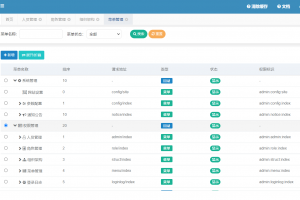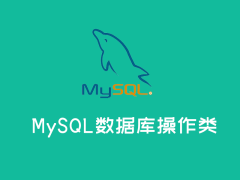简单查询
one(): 根据查询结果返回查询的第一条记录。
all(): 根据查询结果返回所有记录。
count(): 返回记录的数量。
sum(): 返回指定列的总数。
average(): 返回指定列的平均值。
min(): 返回指定列的最小值。
max(): 返回指定列的最大值。
scalar(): 返回查询结果的第一行中的第一列的值。
column(): 返回查询结果中的第一列的值。
exists(): 返回一个值,该值指示查询结果是否有数据。
where(): 添加查询条件
with(): 该查询应执行的关系列表。
indexBy(): 根据索引的列的名称查询结果。
asArray(): 以数组的形式返回每条记录。
应用实例
Customer::find()->one(); 此方法返回一条数据;
Customer::find()->all(); 此方法返回所有数据;
Customer::find()->count(); 此方法返回记录的数量;
Customer::find()->average(); 此方法返回指定列的平均值;
Customer::find()->min(); 此方法返回指定列的最小值 ;
Customer::find()->max(); 此方法返回指定列的最大值 ;
Customer::find()->scalar(); 此方法返回值的第一行第一列的查询结果;
Customer::find()->column(); 此方法返回查询结果中的第一列的值;
Customer::find()->exists(); 此方法返回一个值指示是否包含查询结果的数据行;
Customer::find()->asArray()->one(); 以数组形式返回一条数据;
Customer::find()->asArray()->all(); 以数组形式返回所有数据;
Customer::find()->where($condition)->asArray()->one(); 根据条件以数组形式返回一条数据;
Customer::find()->where($condition)->asArray()->all(); 根据条件以数组形式返回所有数据;
Customer::find()->where($condition)->asArray()->orderBy(‘id DESC’)->all(); 根据条件以数组形式返回所有数据,并根据ID倒序;
2. 关联查询:
[[ActiveRecord::hasOne()]]:返回对应关系的单条记录
[[ActiveRecord::hasMany()]]:返回对应关系的多条记录
应用实例:
//客户表Model:CustomerModel
//订单表Model:OrdersModel
//国家表Model:CountrysModel
//首先要建立表与表之间的关系
//在CustomerModel中添加与订单的关系
Class CustomerModel extends yiidbActiveRecord
{
…
public function getOrders()
{
//客户和订单是一对多的关系所以用hasMany
//此处OrdersModel在CustomerModel顶部别忘了加对应的命名空间
//id对应的是OrdersModel的id字段,order_id对应CustomerModel的order_id字段
return $this ->hasMany(OrdersModel::className(), [ ‘id’ => ‘order_id’ ]);
}
public function getCountry()
{
//客户和国家是一对一的关系所以用hasOne
return $this ->hasOne(CountrysModel::className(), [ ‘id’ => ‘Country_id’ ]);
}
….
}
// 查询客户与他们的订单和国家
CustomerModel::find()->with( ‘orders’ , ‘country’ )->all();
// 查询客户与他们的订单和订单的发货地址
CustomerModel::find()->with( ‘orders.address’ )->all();
// 查询客户与他们的国家和状态为1的订单
CustomerModel::find()->with([
‘orders’ => function ( $query ) {
$query ->andWhere( ‘status = 1’ );
},
‘country’ ,
])->all();
注:with 中的 orders 对应 getOrders
常见问题:
1. 在查询时加了 ->select (); 如下,要加上 order_id,即关联的字段(比如:order_id)比如要在 select 中,否则会报错:undefined index order_id
// 查询客户与他们的订单和国家
CustomerModel::find()->select( ‘order_id’ )->with( ‘orders’ , ‘country’ )->all();
findOne () 和 findAll ():
// 查询key值为10的客户
$customer = Customer::findOne(10);
$customer = Customer::find()->where([ ‘id’ => 10])->one();
// 查询年龄为30,状态值为1的客户
$customer = Customer::findOne([ ‘age’ => 30, ‘status’ => 1]);
$customer = Customer::find()->where([ ‘age’ => 30, ‘status’ => 1])->one();
// 查询key值为10的所有客户
$customers = Customer::findAll(10);
$customers = Customer::find()->where([ ‘id’ => 10])->all();
// 查询key值为10,11,12的客户
$customers = Customer::findAll([10, 11, 12]);
$customers = Customer::find()->where([ ‘id’ => [10, 11, 12]])->all();
// 查询年龄为30,状态值为1的所有客户
$customers = Customer::findAll([ ‘age’ => 30, ‘status’ => 1]);
$customers = Customer::find()->where([ ‘age’ => 30, ‘status’ => 1])->all();
where () 条件:
$customers = Customer::find()->where($cond)->all();
$cond 写法举例:
// SQL: (type = 1) AND (status = 2).
$cond = [ ‘type’ => 1, ‘status’ => 2]
// SQL:(id IN (1, 2, 3)) AND (status = 2)
$cond = [ ‘id’ => [1, 2, 3], ‘status’ => 2]
//SQL:status IS NULL
$cond = [ ‘status’ => null]
[[and]]: 将不同的条件组合在一起,用法举例:
//SQL:`id=1 AND id=2`
$cond = [ ‘and’ , ‘id=1’ , ‘id=2’ ]
//SQL:`type=1 AND (id=1 OR id=2)`
$cond = [ ‘and’ , ‘type=1’ , [ ‘or’ , ‘id=1’ , ‘id=2’ ]]
[[or]]:
//SQL:`(type IN (7, 8, 9) OR (id IN (1, 2, 3)))`
$cond = [ ‘or’ , [ ‘type’ => [7, 8, 9]], [ ‘id’ => [1, 2, 3]]
[[not]]:
//SQL:`NOT (attribute IS NULL)`
$cond = [ ‘not’ , [ ‘attribute’ => null]]
[[between]]: not between 用法相同
//SQL:`id BETWEEN 1 AND 10`
$cond = [ ‘between’ , ‘id’ , 1, 10]
[[in]]: not in 用法类似
//SQL:`id IN (1, 2, 3)`
$cond = [ ‘in’ , ‘id’ , [1, 2, 3]]
//IN条件也适用于多字段
$cond = [ ‘in’ , [ ‘id’ , ‘name’ ], [[ ‘id’ => 1, ‘name’ => ‘foo’ ], [ ‘id’ => 2, ‘name’ => ‘bar’ ]]]
//也适用于内嵌sql语句
$cond = [ ‘in’ , ‘user_id’ , ( new Query())->select( ‘id’ )->from( ‘users’ )->where([ ‘active’ => 1])]
[[like]]:
//SQL:`name LIKE ‘%tester%’`
$cond = [ ‘like’ , ‘name’ , ‘tester’ ]
//SQL:`name LIKE ‘%test%’ AND name LIKE ‘%sample%’`
$cond = [ ‘like’ , ‘name’ , [ ‘test’ , ‘sample’ ]]
//SQL:`name LIKE ‘%tester’`
$cond = [ ‘like’ , ‘name’ , ‘%tester’ , false]
[[exists]]: not exists 用法类似
//SQL:EXISTS (SELECT “id” FROM “users” WHERE “active”=1)
$cond = [ ‘exists’ , ( new Query())->select( ‘id’ )->from( ‘users’ )->where([ ‘active’ => 1])]
此外,您可以指定任意运算符如下
//SQL:`id >= 10`
$cond = [ ‘>=’ , ‘id’ , 10]
//SQL:`id != 10`
$cond = [ ‘!=’ , ‘id’ , 10]
常用查询:
// WHERE admin_id >= 10 LIMIT 0,10
User::find()->select( ‘*’ )->where([ ‘>=’ , ‘admin_id’ , 10])->offset(0)->limit(10)->all()
// SELECT `id`, (SELECT COUNT(*) FROM `user`) AS `count` FROM `post`
$subQuery = ( new Query())->select( ‘COUNT(*)’ )->from( ‘user’ );
$query = ( new Query())->select([ ‘id’ , ‘count’ => $subQuery ])->from( ‘post’ );
// SELECT DISTINCT `user_id` …
User::find()->select( ‘user_id’ )->distinct();
更新:
//update();
//runValidation boolen 是否通过validate()校验字段 默认为true
//attributeNames array 需要更新的字段
$model ->update( $runValidation , $attributeNames );
//updateAll();
//update customer set status = 1 where status = 2
Customer::updateAll([ ‘status’ => 1], ‘status = 2’ );
//update customer set status = 1 where status = 2 and uid = 1;
Customer::updateAll([ ‘status’ => 1], [ ‘status’ => ‘2’ , ‘uid’ => ‘1’ ]);
删除:
$model = Customer::findOne( $id );
$model -> delete ();
$model ->deleteAll([ ‘id’ =>1]);
批量插入:
Yii:: $app ->db->createCommand()->batchInsert(UserModel::tableName(), [ ‘user_id’ , ‘username’ ], [
[ ‘1’ , ‘test1’ ],
[ ‘2’ , ‘test2’ ],
[ ‘3’ , ‘test3’ ],
])->execute();
查看执行 sql
//UserModel
$query = UserModel::find()->where([ ‘status’ =>1]);
echo $query ->createCommand()->getRawSql();




![[开源推荐] Yii2开发的简单日程管理后台](https://www.viphper.com/wp-content/uploads/2022/12/2626c80728cab06-300x200.png)
![[开源推荐] yii2-cdn 支持七牛、网易云、腾讯云、阿里云的cdn](https://www.viphper.com/wp-content/uploads/2022/12/4c53b2a47e5cd5f-300x200.jpeg)
![[开源推荐] 适用于yii2的支付扩展包,支持支付宝、微信、银联支付](https://www.viphper.com/wp-content/uploads/2022/12/3694aa5b10f1dab-300x200.jpeg)
![[开源推荐] 基于yii2的restful接口自动生成在线文档](https://www.viphper.com/wp-content/uploads/2022/11/1fb1a60a4417ec2-300x200.jpeg)











![[开源推荐] PHP DFA算法实现敏感词过滤包 php-dfa-sensitive](https://www.viphper.com/wp-content/uploads/2022/11/0f78983556550e6-240x180.png)




